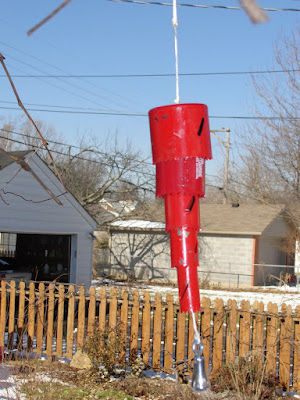About two months ago I began work on a mandolin, using wood gifted to me from various folks. The soundboard is bookmatched pine from a huge old barn beam. The neck, sides, and back are made from mahogany scraps from a local furniture maker. Anyway, I was reading Roger Siminoff's mandolin book (and following his plans, mostly). I prepared my sides, soundboard, back and neck. I chose to use the v-shaped dovetail joint to join the neck to the body, but when I went to cut the dovetail on the neck, I made a terrible mistake. Although I cut to my line, my saw bowed inside the cut. The result was a haphazard cut, deep in the base of the neck, that no amount of sanding could remove. Well, consider that neck dead.
Like a phoenix, the neck rose from its own ashes, sort of...
But, I never throw anything away. I'd spent too long choosing just the right piece of wood, shaping the neck profile. I just put the neck back on the shelf, with the rest of the mandolin, and moved on to other projects until I could live down my disgust.
Well, I guess I did. I was spurred into action after getting the new issue of Make Magazine. I read Make from cover to cover. Most of their articles are about electronics or micro-controller projects, but often they have musical projects as well. So, what got me moving? The MYO cigar box guitar article. There's even a thumb of the project on the cover. Link to the article here: http://makezine.com/21/cbg/
I didn't follow their plans, I was just inspired.
So I asked my wife where do we keep the old cigar boxes. Surprisingly, she knew. She buys them as funky organizational aids and we were well stocked. I chose a slight, all cedar "Hoyo de Monterrey" from Honduras that made a nice loud sound when I thumped it.
El old cigar box la Tapa Negra...
I noticed in the make article, and from image searches, that most CBG's use the lid as the soundboard. I consider this to be a mistake. The lid on my box is only held on by a glued paper hinge. Also, the paper glued on the lid could act as a damper. Thus, the bottom became the top. .
But what to use for a neck? It would be fairly easy to make a flat, one piece neck for a simple two or three string guitar, but I want something that can play. That's when I found the ruined neck from my previous project. This could work.
The belt sander saved the old neck, and with a few strokes from my highly recommended Erik Frost carving knife that I never accidentally stab myself with (product placement), the new neck came into being.
Detail of the neck joint... I glues and screws it, then I uses it...
I chose to meet the body at 6 degrees, as Siminoff suggests. Mine meets at the sixteenth fret, which puts bridge height at just under 3/4 inch. I chose a 13" scale, which is a bit small, but reduces the tension on the neck.
Speaking of tension, how do you make a cheap little cigar box carry these loads?
1) Reinforce the box. You can't trust those little box joints. Glue in some lightweight corner braces. Pine will do. Mahogany is better.
2) Brace the soundboard somehow. There are myriad ways, X-brace, tone bars, fan bracing... Because the soundboard is so small on this instrument, I elected to combine the bridge reinforcement with a diagonal spar. My brace is a piece of picket fence cedar that split naturally into this beautiful diamond shape, which I then cleaned up on the belt sander.
No guts, no glory...
3) Neck block. A lightweight pine neck block will do. Whatever type of neck joint you are using, you will need to design the neck block appropriately. In this case, the neck block receives the screws for the neck joint. Make sure that the neck block does not make contact with the soundboard on an instrument this small. You will have NO bass response.
4) Tail Block. Also made from pine, receives the strap button and tail piece.
5) Lid. The force generated by the strings puts the back of the instrument in tension. By screwing the lid down, much of this will travel through the lid rather than the body.
Two screws in the lid allow it to carry tension...
Fin- The complete mandolin rests in its autoharp case...











